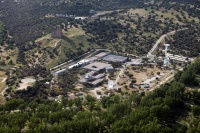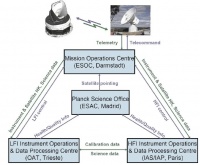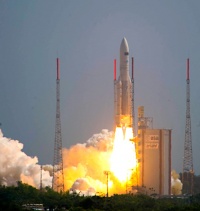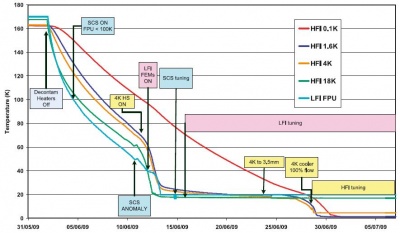Difference between revisions of "Ground Segment and Operations"
| Line 92: | Line 92: | ||
The first (14.35 m s−1), intended to correct for errors in the rocket injection, was executed on 15 May at 20:01:05 UT, with a slight over-performance of 0.9% and an error in direction of 1◦. 3 (a touch-up manoeuvre was carried out on 16 May at 07:17:36 UT). The second and major (mid-course) manoeuvre (153.6 m s−1) took place between 5 and 7 June, and a touch-up (11.8 m s−1) was executed on 17 June. The third and final manoeuvre (58.8 m s−1), to inject Planck into its final orbit, was executed between 2 and 3 July. The total fuel consumption of these manoeuvres, which were carried out using Planck’s coarse (20 N) thrusters, was 205 kg. | The first (14.35 m s−1), intended to correct for errors in the rocket injection, was executed on 15 May at 20:01:05 UT, with a slight over-performance of 0.9% and an error in direction of 1◦. 3 (a touch-up manoeuvre was carried out on 16 May at 07:17:36 UT). The second and major (mid-course) manoeuvre (153.6 m s−1) took place between 5 and 7 June, and a touch-up (11.8 m s−1) was executed on 17 June. The third and final manoeuvre (58.8 m s−1), to inject Planck into its final orbit, was executed between 2 and 3 July. The total fuel consumption of these manoeuvres, which were carried out using Planck’s coarse (20 N) thrusters, was 205 kg. | ||
| − | [[file:Trajectory.pdf| | + | [[file:Trajectory.pdf|thumb|500px|center|The trajectory of Planck from launch until 6 June 2010, in Earth-centred rotating coordinates (X is in the Sun-Earth direction, and Z points to the north ecliptic pole). Diamond symbols indicate the major manoeuvres, while triangles are touch-up operations. Two orbits around L2 have been carried out in this period. The orbital periodicity is ∼6 months. The distance from the Earth-Moon barycentre is shown at bottom right. ]] |
Once in its final orbit, very small manoeuvres were required at approximately | Once in its final orbit, very small manoeuvres were required at approximately | ||
Revision as of 10:08, 23 November 2017
Contents
Geographical distribution of the Planck Ground Segment[edit]
The Planck Ground Segment consists of four geographically distributed centres.
The Mission Operations Centre[edit]
The mission operations centre (MOC), located at ESA’s operations centre in Darmstadt (Germany), was responsible for all aspects of flight control and of the health and safety of the Planck spacecraft, including both instruments. It planned and executed all necessary satellite activities, including instrument commanding requests by the instrument operations centres.
MOC communicated with the satellite using ESA’s 35-m antenna located in New Norcia (Australia), or that in Cebreros (Spain), over a daily 3-h period, during which it uplinked a scheduled activity timeline which was autonomously executed by the satellite, and downlinked the science and housekeeping (HK) data acquired by the satellite during the past 24 h. The downlinked data were transferred from the antenna to the MOC over a period of typically 8 h; at MOC they were put onto a data server from where they were retrieved by the two data processing centres.
The Planck Science Office[edit]
The Planck Science Office (PSO) is located at ESA’s European Space Astronomy Centre in Villanueva de la Cañada surroundings (Madrid, Spain).
Its main responsibilities include:
- coordinating scientific operations of the Planck instruments;
- designing, planning and executing the Planck observation strategy;
- providing MOC with a detailed pointing plan with a periodicity of about one month;
- creating and updating the specifications of the Planck Legacy Archive (PLA) developed by the Science Archives Team at ESAC;
- testing and operating the PLA.
The LFI instrument operations and data-processing centre[edit]
The LFI instrument operations and data processing centre, located at the Osservatorio Astronomico di Trieste (Italy), is responsible for the operation of the LFI instrument, and the processing of the data acquired by LFI into the final scientific products of the mission.
The HFI instrument operations and data-processing centre[edit]
The HFI instrument operations and data processing centres, located, respectively, at the Institut d’Astrophysique Spatiale in Orsay (France) and at the Institut d’Astrophysique de Paris (France), are similarly responsible for the operation of the HFI instrument, and (with several other institutes in France and the UK) for the processing of the data acquired by HFI into the final scientific products of the mission.
Data flow in the Planck Ground Segment[edit]
The PSO sent the Pre-Programmed Pointing Lists (PPL) to the MOC. The Flight Dynamics team at ESOC adapted them into Augmented Pre-Programmed Pointing Lists (APPL) taking into account ground station scheduling, Operational Day (OD) boundaries and other issues.
MOC sent pointing and instrument commands to the spacecraft, and received the house-keeping telemetry and science data through the ground stations (for Planck, mostly the New Norcia and Cebreros ones).
Science data were then transferred to both data processing centres (DPCs), which processed the data and sent quality reports to PSO.
Science products (timelines, maps, etc) have been regularly exchanged between DPCs in order to assist with calibration, systematics, and scientific issues.
More information about the Planck Ground Segment may be found in Planck-PreLaunch-I[1].
Early operations and transfer to orbit[edit]
Planck was launched from the Centre Spatial Guyanais in Kourou (French Guyana) on 14 May 2009 at its nominal lift-off time of 13:12 UT, on an Ariane 5 ECA rocket of Arianespace. ESA’s Herschel observatory was launched on the same rocket. At 13:37:55 UT, Herschel was released from the rocket at an altitude of 1200 km; Planck followed suit at 13:40:25UT. The separation attitudes of both satellites were within 0.1° of prediction. The Ariane rocket placed Planck with excellent accuracy (semimajor axis within 1.6% of prediction), on a trajectory towards the second Lagrangian point of the Earth-Sun system (L2). The orbit describes a Lissajous trajectory around L2 with a roughly six month period that avoids crossing the Earth penumbra for at least four years.
After release from the rocket, three large manoeuvres were carried out to place Planck in its intended final orbit. The first (14.35 m s−1), intended to correct for errors in the rocket injection, was executed on 15 May at 20:01:05 UT, with a slight over-performance of 0.9% and an error in direction of 1◦. 3 (a touch-up manoeuvre was carried out on 16 May at 07:17:36 UT). The second and major (mid-course) manoeuvre (153.6 m s−1) took place between 5 and 7 June, and a touch-up (11.8 m s−1) was executed on 17 June. The third and final manoeuvre (58.8 m s−1), to inject Planck into its final orbit, was executed between 2 and 3 July. The total fuel consumption of these manoeuvres, which were carried out using Planck’s coarse (20 N) thrusters, was 205 kg.
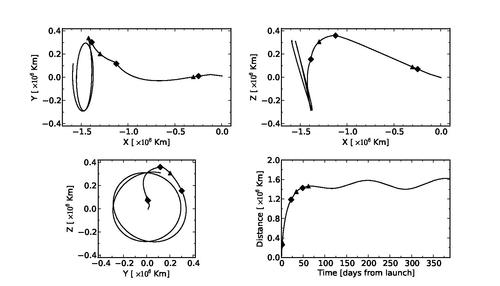
Once in its final orbit, very small manoeuvres were required at approximately monthly intervals (1 m/s per year) to keep Planck from drifting away from its intended path around L2. The attitude manoeuvres required to follow the scanning strategy need about 2.6 m/s per year. Overall, the excellent performance of launch and orbit manoeuvres led to a large amount of fuel remaining on board at end of mission operations.
Planck started cooling down radiatively shortly after launch. Heaters were activated to hold the focal plane at 250 K, which was reached around 5 h after launch. The valve opening the exhaust piping of the dilution cooler was activated at 03:30 UT, and the 4He-JT cooler compressors were turned on at low stroke at 05:20 UT. After these essential operations were completed, on the second day after launch, the focal plane temperature was allowed to descend to 170 K for out-gassing and decontamination of the telescope and focal plane.
Commissioning and initial science operations[edit]
Commissioning[edit]
The first period of operations focussed on commissioning activities, i.e., functional check-out procedures of all sub-systems and instruments of the Planck spacecraft, in preparation for running science operations related to calibration and performance verification of the payload. Planning for commissioning operations was driven by the telescope decontamination period of 2 weeks and the subsequent cryogenic cool-down of the payload and instruments. The overall duration of the cool-down was approximately 2 months, including the decontamination period. The commissioning activities were executed very smoothly and all sub-systems were found to be in good health. The commissioning activities were formally completed at the time when the HFI bolometer stage reached its target temperature of 100 mK, on 3 July 2009 at 01:00 UT. At this time all the critical resource budgets (power, fuel, lifetime, etc.) were found to contain very significant margins with respect to the original specification.
Calibration and performance verification[edit]
Calibration and performance verification (CPV) activities started during the cool-down period and continued until the end of August 2009. On completion of all the planned activities, it was concluded that the two instruments were fully tuned and ready for routine operations. No further parameter tuning was expected to be needed, except for the sorption cooler, which required a weekly change in operational parameters. The scientific performance parameters of both instruments were in most respects as had been measured on the ground before launch. The only significant exception was that, due to the high level of Galactic cosmic rays, the bolometers of HFI were detecting a higher number of glitches than expected, causing a modest (about 10%) increase of systematic effects on their noise levels. The satellite did not introduce any major systematic effects into the science data. In particular, the telemetry transponder did not result in radio-frequency interference, which implies that the data acquired during visibility periods is usable for science.
First-Light Survey[edit]
The First Light Survey (FLS) was the last major activity planned before the start of routine surveying of the sky. It was conceived as a two-week period during which Planck would be fully tuned up and operated as if it was in its routine phase. This stable period could have resulted in the identification of further tuning activities required to optimise the performance of Planck in the long-duration surveys to come. The FLS was conducted between 13 and 27 August, and in fact led to the conclusion that the Planck payload was operating stably and optimally, and required no further tuning of its instruments. Therefore the period of the FLS was accepted as a valid part of the first Planck survey.
Routine operations phase[edit]
The routine operations phase of Planck is characterized by continuous and stable scanning of the sky and data acquisition by LFI and HFI. It started with the FLS on 13 August 2009.
The Planck satellite generated (and stored on-board) data continuously at the following typical rates: 21 kilobit/s (kbps) of house-keeping (HK) data from all on-board sources, 44 kbps of LFI science data and 72 kbps of HFI science data. The data were brought to ground in a daily pass of approximately 3 h duration. Besides the data downloads, the passes also acquired realtime HK and a 20 min period of real-time science (used to monitor instrument performance during the pass). Planck utilized the two ESA deep-space ground stations in New Norcia (Australia) and Cebreros (Spain). Scheduling of the daily telecommunication period was quite stable, with small perturbations due to the need to coordinate the use of the antenna with other ESA satellites (in particular Herschel). At the ground station the telemetry was received by redundant chains of front-end/back-end equipment. The data flowed to the mission operations control centre (MOC) located at ESOC in Darmstadt (Germany), where they were processed by redundant mission control software (MCS) installations and made available to the science ground segment. To reduce bandwidth requirements between the station and ESOC only one set of science telemetry was usually transferred. Software was run post-pass to check the completeness of the data. This software check was also used to build a catalogue of data completeness, which was used by the science ground segment to control its own data transfer process. Where gaps were detected, attempts to fill them were made as an offline activity (normally next working day), the first step being to attempt to reflow the relevant data from station. Early in the mission these gaps were more frequent, with some hundreds of packets affected per week (impact on data return of order 50 ppm), due principally to a combination of software problems with the data ingestion and distribution in the MCS, and imperfect behaviour of the software gap check. Software updates implemented during the mission improved the situation, such that gaps became much rarer, with a total impact on data return well below 1 ppm. Redump of data from the spacecraft was attempted when there had been losses in the space link. This was only necessary on very few occasions. In each case the spacecraft redump successfully recovered all the data.
All the data downloaded from the satellite, and processed products such as filtered attitude information, were made available each day for retrieval from the MOC by the LFI and HFI data processing centres (DPCs).
The scanning strategy was the following: the spin axis follows a cycloidal path on the sky by step-wise displacements of 2 arcmin approximately every 50 min. The dwell time (i.e., the duration of stable data acquisition at each pointing) varied sinusoidally by a factor of approximately 2. Planck’s scanning strategy resulted in significantly inhomogeneous depth of integration time across the sky; the areas near the ecliptic poles were observed with greater depth than all others.
The scanning strategy for the second year of Routine Operations was exactly the same as for the first year, except that all pointings were shifted by 1 arcmin along the cross-scanning direction, in order to provide finer sky sampling for the highest frequency detectors when combining two years of observations.
The remaining two years of operations, including Surveys 6 to 8 of the LFI-only phase, made use of a change in the cycloid phase of 90 degrees in order to spread out scanning directions over the sky.
Orbit maintenance manoeuvres were carried out at approximately monthly intervals. Although the manoeuvres only required a few minutes, preparations, post-manoeuvre mass properties calibration, and re-entry into scientific slewing mode increased the overhead to several hours. The manoeuvres were carried out without disturbing the path of the spin axis from its nominal scanning law. The dwell times of pointings before and after the execution of the manoeuvre were reduced to allow all pre-planned pointings to be carried out.
While the Planck detectors were scanning the sky, they also naturally observed celestial calibrators. The main objects used for this purpose were the Crab Nebula, and the bright planets Mars, Jupiter, and Saturn.
Major operational milestones[edit]
Planck was launched from the Centre Spatial Guyanais in Kourou (French Guyana) on 14 May 2009 at its nominal lift-off time of 13:12 UT, on an Ariane 5 ECA rocket of Arianespace.
On 13 August 2009, Planck started its first all-sky survey after successfully concluding its commissioning phase.
On 14 January 2012, Planck’s HFI completed its survey of the early Universe after running out of coolant as expected. Able to work at higher temperatures, the LFI continued surveying the sky until 3 October 2013.
On 4 October 2013 Planck ended its routine operations, after executing its last observation of the Crab Nebula, and started its decommissioning activities.
On 19 October 2013, the sorption cooler and the two instruments (LFI and HFI) were switched off.
The final command to the Planck satellite was sent on 23 October 2013, marking the end of operations.
Contingencies[edit]
The main unplanned events included the following.
- Very minor deviations from the scanning law included occasional (on the average about once every two months) under-performance of the 1-N thrusters used for regular manoeuvres, which implied that the corresponding pointings were not at the intended locations. These deviations had typical amplitudes of 30 arcsec, and had no significant impact on the coverage map.
- The thruster heaters were unintentionally turned off between 31 August and 16 September 2009 (the so-called “catbed” event).
- An operator error in the upload of the on-board command timeline led to an interruption of the normal sequence of manoeuvres and therefore to Planck pointing to the same location on the sky for a period of 29 h between 20 and 21 November 2009 (“the day Planck stood still”). Observations of the nominal scanning pattern resumed on 22 November, and on 23 November a recovery operation was applied to survey the previously missed area. During the recovery period the duration of pointing was decreased to allow the nominal law to be caught up with. As a side effect, the RF transmitter was left on for longer than 24 h, which had a significant thermal impact on the warm part of the satellite.
- As planned, the RF transmitter was initially turned on and off every day in synchrony with the daily visibility window, in order to reduce potential interference by the transmitter on the scientific data. The induced daily temperature variation had a measurable effect throughout the satellite. An important effect was on the temperature of the 4He-JT cooler compressors, which caused variations of the levels of the interference lines that they induce on the bolometer data (Planck HFI Core Team 2011a). Therefore the RF transmitter was left permanently on starting from 25 January 2010 (257 days after launch), which made a noticeable improvement on the daily temperature variations.
- During the coverage period, the operational star tracker switched autonomously to the redundant unit on two occasions (11 January 2010 and 26 February 2010); the nominal star tracker was restored a short period later (3.37 and 12.75 h, respectively) by manual power-cycling. Although the science data taken during this period have normal quality, they have not been used, because the redundant star tracker’s performance is not fully characterized.
For more information, see [2]. For a complete list of operational events, including contigencies, see the POSH (Planck operational state history).
For more information[edit]
A complete overview of the Planck mission and its science programme can be found in the Blue Book.
More details on the Planck mission performance can be found in [2], .
A complete list of Planck publications can be found here.
References[edit]
- ↑ Planck pre-launch status: The Planck mission, J. A. Tauber, N. Mandolesi, J.-L. Puget, et al. , A&A, 520, A1+, (2010).
- ↑ 2.02.1 Planck early results. I. The Planck mission, Planck Collaboration I, A&A, 536, A1, (2011).
[ESA's] Mission Operation Center [Darmstadt, Germany]
European Space Agency
House Keeping
Planck Science Office
Planck Legacy Archive
(Planck) Low Frequency Instrument
(Planck) High Frequency Instrument
Pre-programmed Pointing List
European Space Operations Centre (Darmstadt)
Augmented Preprogrammed Pointing List
Operation Day definition is geometric visibility driven as it runs from the start of a DTCP (satellite Acquisition Of Signal) to the start of the next DTCP. Given the different ground stations and spacecraft will takes which station for how long, the OD duration varies but it is basically once a day.
Calibration and Performance Verification

